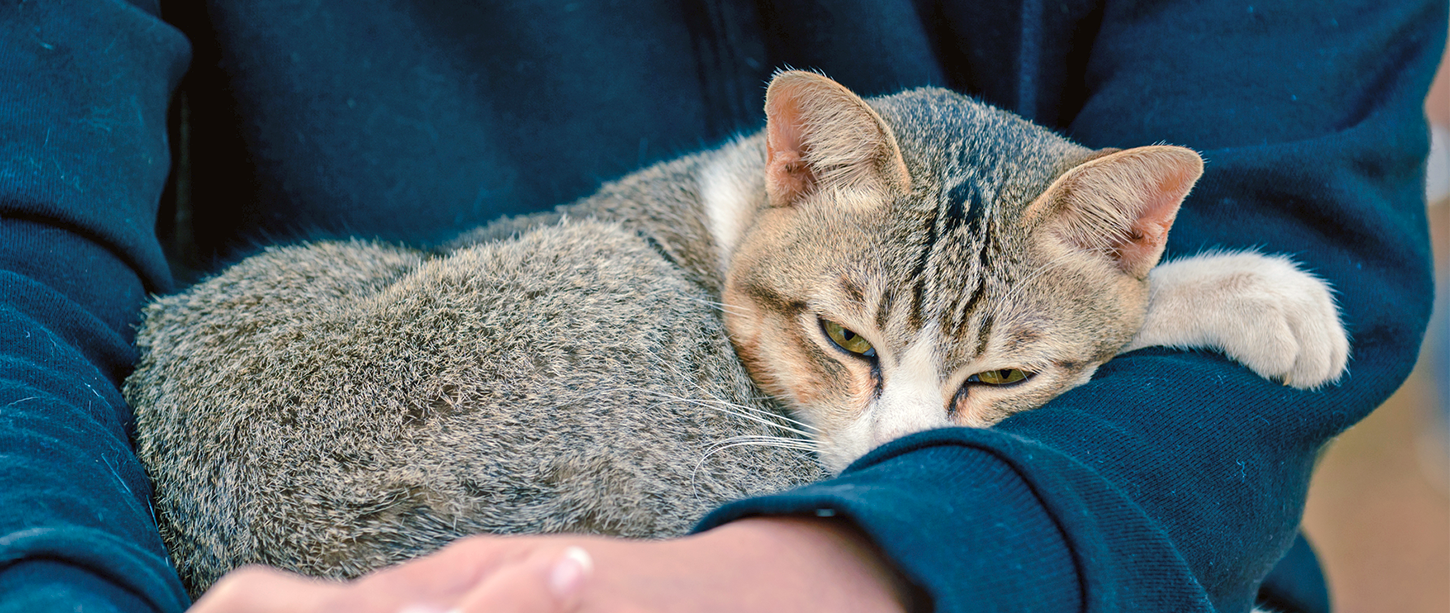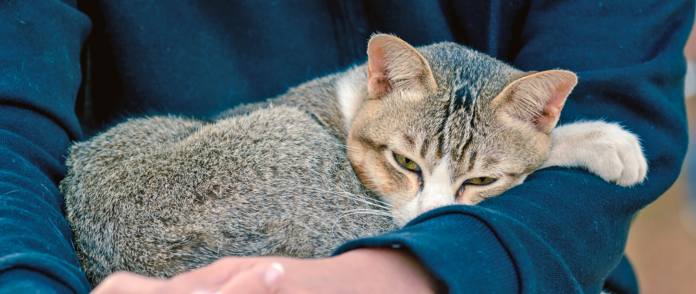
itman47 | Deposit Photos
The Animal Cancer Foundation says that of the 32 million cats in the United States, 6 million are diagnosed with cancer each year. That’s a staggering number, and researchers are working hard to find cures. Among the most recent advances in oncology is immunotherapy. While standard cancer therapies—chemotherapy, radiation, surgery—directly destroy cancers, they also may harm normal cells and tissues. Immunotherapy is different. It destroys only the abnormal cells.
Immunotherapy uses your cat’s own immune system to fight cancer. A healthy immune system is triggered when it detects a rapid replication of cancer cells. Unfortunately, however, it’s sometimes not enough: The cancer cells may get ahead of the immune system. This may be due to the cat’s immune system not being strong enough to react or because the cancer cells are somehow “hidden” from recognition. In cases like these, researchers believe, the immune system needs to be stimulated or jump-started to recognize the foreign cells and attack them.
Not Yet Perfect
While immunotherapy sounds perfect, there are caveats. Immunotherapy tends to work best after a tumor has been “debulked” (made smaller by surgical removal, radiation, or chemotherapy), which means immunotherapy is more of an adjunct to traditional therapies and adds to the cost of cancer treatment.
In addition, much of what we know about feline immunotherapy has been extrapolated from work with humans and lab animals. At the moment, it’s difficult to determine which cats will benefit from immunotherapy and which therapies have trials and data backing their safety and efficacy will benefit from immunotherapy.
“One challenge with immunotherapy is predicting which patients will respond. There is a lot of research going on (some of which is currently funded by the Cornell Feline Health Center) both to find ways to increase the number of patients that respond to immunotherapies and to identify biomarkers that will predict which patients will respond,” says oncologist Kelly R. Hume, DVM, DACVIM, Associate Professor, Clinical Sciences at the New York State College of Veterinary Medicine at Cornell.
“Because there are very few immunotherapies available in veterinary medicine, there are still many hurdles to overcome in commercializing these products,” says Dr. Hume. “Practitioners and owners need to be vigilant about requesting peer-reviewed efficacy and safety data on immunotherapy products that are commercially available.”
Vaccine Possibilities
Oncept, a vaccine designed to prevent or minimize metastasis (spread) or recurrence of oral melanomas in dogs, has been tested for use in cats. In cats, the most common location for melanomas is in the iris of the eye. Studies show that the vaccine is relatively safe for use in cats with minimal side effects. Efficacy for prolonged survival is not yet known.
A vaccine of recombinant canarypox virus expressing feline interleukin-2 (IL-2) is approved for use in Europe as adjunctive immunotherapy after surgery for some feline cancers, including feline injection-site sarcomas, or fibrosarcomas. (IL-2 is an important T cell stimulatory cytokine approved as an exogenous anti-tumor agent.)
Called Oncept IL-2, this vaccine is indicated for cats with fibrosarcoma (2 to 5 centimeters in diameter, which is of an inch to two inches) without detectable metastasis or lymph node involvement. The goal of Oncept IL-2 is to reduce the risk of relapse and to increase the relapse-free interval. It should be used in addition to surgery and radiotherapy. The vaccine requires multiple injections and is not recommended for cats who already have metastases to the lungs.
While it does seem counterintuitive to give a vaccine for a vaccine-related cancer, results show that this approach may provide some benefit. It is currently conditionally licensed for use in the U.S. with clinical trials ongoing at the University of Pennsylvania. Research is encouraging: “In the absence of immunotherapy, tumor recurrence was observed in 61% of animals within a 12-month follow-up period after treatment with surgery and iridium-based radiotherapy. In contrast, only 39 and 28% of cats receiving either NYVAC-human IL2 or ALVAC-feline IL2, respectively, exhibited tumor recurrences” (see https://www.ncbi.nlm.nih.gov/pubmed/14625567).
Autologous Vaccines
Vaccines called “autologous vaccines,” are made from tissues extracted when a tumor is surgically removed. In this process, antigens on the tumor cells are isolated and used to develop a vaccine that is unique to your cat and her cancer. Because her own cells are used, the likelihood of any major reactions is low.
“The science behind the technology is the idea that every patient’s tumor is different, and so an immunotherapy of some kind that’s ‘off the shelf’ and intended to treat every tumor is simply at a disadvantage because of the diversity of tumors,” says Mark Suckow, DVM, chief scientific officer for Torigen Pharmaceuticals, a company that specializes in cancer immunotherapy, in an interview in American Veterinarian.
“The vaccine stimulates the immune system, resulting in a cascade of events that culminate in the stimulation of T-lymphocyte cells, which respond and attack the tumor based upon the antigens that we have provided,” says Dr. Suckow.
Cats who are using this therapy receive three injections one week apart (so far, 88 cats have been treated).
Cancer types ranged from melanoma to hemangiosarcoma, with squamous cell carcinomas and vaccine-associated fibrosarcomas being the most common. More time is needed to evaluate efficacy, but this is a promising option.
At Cornell
One of the studies funded by the Cornell Feline Health Center is being carried out at Cornell University and is headed by Cynthia Leifer PhD. This project is looking at chimeric antigen receptor (CAR) immunotherapy to eradicate feline alimentary T cell lymphoma. Lymphoma is the third most common feline cancer. The alimentary form attacks the gastrointestinal tract, the liver, and other abdominal organs. Survival time is currently poor, with most cats succumbing in six to 24 months.
The technique involves taking T lymphocytes from cats with this cancer and modifying the cells genetically. Introducing CARs into the cells is believed to “prime” the cells to find and destroy cancer cells. The modified cells are then reintroduced into the cancer patients. This type of immunotherapy has shown promise in people and is being looked at in dogs and cats.
The Future
Immunotherapy is part of the future in feline oncology. With multiple ongoing studies and more research being devoted to feline health, cancer options for your cat will continue to grow, with treatments customized to the individual cat and her cancer. There is great hope in the veterinary community that prognoses for survival and increased quality of life will improve as a result of this important work.

MAJIVECKA | Deposit photos
5 Questions About Cancer Therapies
Your input into your cat’s treatment is important.
In a recent issue of DVM360, Michael O. Childress DVM offered five important questions to ask about cancer treatment. Your involvement in your cat’s care and treatment decisions is important.
1. Does this therapy appear in peer-reviewed scientific literature? That means people knowledgeable about feline cancer have evaluated the treatment.
2. Are there published clinical trials using this therapy in cats with naturally occurring disease? In this case, the reports show results of using this method for cats with the same cancer as your cat in “the real world.”
3. What are the pharmacokinetics and pharmacodynamics of the drug being considered? This refers to the metabolism, distribution, and effects of the drug being used. Has this drug been evaluated and used in cats?
4. How was the benefit of this drug evaluated? There are two primary ways to look at effectiveness of a chemotherapy drug. The first is the effect on the actual tumor, i.e. did it shrink? The second is: Did it increase the life span and/or quality of life of the cats who were treated with it?
5. What side effects and complications may occur in a cat as a result of this treatment? It’s important because vomiting for a week may be acceptable to you but permanent incontinence may not.




